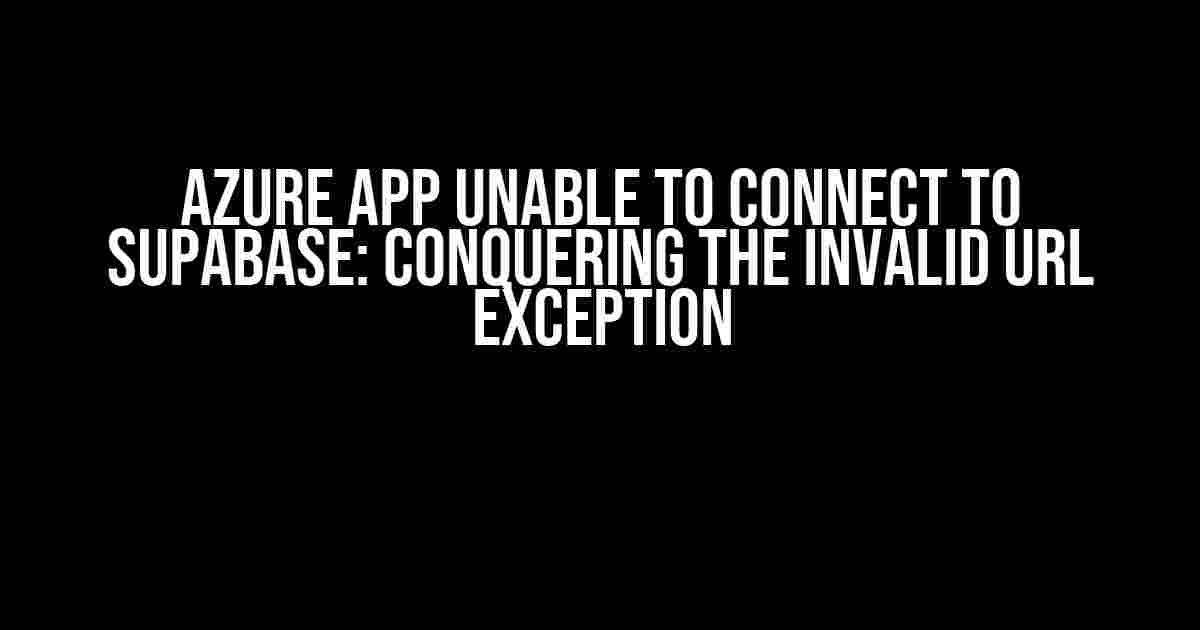Are you tired of seeing that dreaded “Invalid URL Exception” error when trying to connect your Azure app to Supabase? You’re not alone! In this article, we’ll dive into the world of Azure and Supabase, exploring the common causes of this error and, more importantly, how to fix it. Buckle up, folks, as we embark on a troubleshooting adventure!
The Anatomy of the Error
Before we dive into the solutions, let’s take a closer look at the error itself. The “Invalid URL Exception” error typically occurs when your Azure app attempts to establish a connection to Supabase, but the URL provided is malformed or incorrect. This can happen due to a variety of reasons, including:
- Incorrect Supabase URL or endpoint
- Typo in the connection string
- Misconfigured Azure app settings
- Firewall or proxy issues
Step 1: Verify the Supabase URL and Endpoint
The first step in resolving the “Invalid URL Exception” error is to double-check your Supabase URL and endpoint. Ensure that:
- The Supabase URL is correct and in the correct format (e.g.,
https://your-supabase-instance.supabase.io) - The endpoint is correctly specified (e.g.,
/rest/v1/or/graphql/v1/) - The URL and endpoint are correctly concatenated (e.g.,
https://your-supabase-instance.supabase.io/rest/v1/)
const supabaseUrl = 'https://your-supabase-instance.supabase.io';
const endPoint = '/rest/v1/';
const connectionString = `${supabaseUrl}${endPoint}`;
Step 2: Inspect the Connection String
Next, carefully examine your connection string to ensure it’s correctly formatted and free of typos. Pay attention to:
- Username and password (if using basic authentication)
- Database name and schema (if applicable)
- Any additional connection parameters (e.g., SSL mode)
const connectionString = `postgresql://${username}:${password}@${supabaseUrl}:${port}/${database}?sslmode=${sslMode}`;
Step 3: Check Azure App Settings
Now, let’s shift our focus to your Azure app settings. Verify that:
- Supabase connection settings are correctly configured in Azure App Service settings
- Environment variables are set correctly (e.g.,
SUPABASE_URL,SUPABASE_ENDPOINT) - App settings are correctly deployed to Azure (e.g., via Azure Pipelines)
| Azure App Setting | Value |
|---|---|
| SUPABASE_URL | https://your-supabase-instance.supabase.io |
| SUPABASE_ENDPOINT | /rest/v1/ |
Step 4: Investigate Firewall and Proxy Issues
Sometimes, firewall or proxy issues can prevent your Azure app from connecting to Supabase. To troubleshoot this:
- Check Azure App Service’s outgoing IP addresses and ensure they’re not blocked by Supabase’s firewall
- Verify that your Azure app’s proxy settings are correctly configured (if using a proxy)
- Test your Azure app’s connectivity to Supabase using a tool like
curlorPostman
curl -v https://your-supabase-instance.supabase.io/rest/v1/
Additional Troubleshooting Tips
In addition to the steps outlined above, here are some additional tips to help you conquer the “Invalid URL Exception” error:
- Enable detailed error logging in your Azure app to gain more insights into the error
- Use tools like Fiddler or Wireshark to debug HTTP traffic between your Azure app and Supabase
- Test your Supabase connection using a separate tool or script to isolate the issue
Conclusion
By following these steps and troubleshooting tips, you should be able to resolve the “Invalid URL Exception” error and successfully connect your Azure app to Supabase. Remember to stay calm, be patient, and carefully examine each potential cause of the error. With persistence and attention to detail, you’ll be up and running in no time!
Happy coding, and don’t hesitate to reach out if you have any further questions or need additional assistance!
Frequently Asked Question
Are you stuck with an Azure app that’s unable to connect to Supabase, throwing an invalid URL exception? Don’t worry, we’ve got you covered!
What is the most common cause of an invalid URL exception when connecting to Supabase from an Azure app?
The most common cause is a misconfigured URL or endpoint. Double-check that your Supabase URL is correct and follows the correct format, including the schema (https), domain, and port number (if applicable).
How can I troubleshoot the invalid URL exception in my Azure app?
Try the following steps: 1) Check the Supabase URL in your Azure app configuration, 2) Verify the Supabase URL using a tool like Postman or cURL, 3) Enable debug logging in your Azure app to capture more detailed error messages, and 4) Review the Supabase documentation for any specific requirements or restrictions on URL formats.
What are some common URL formats for connecting to Supabase from an Azure app?
Common URL formats for connecting to Supabase include: https://[your-supabase-instance].supabase.io, https://[your-supabase-instance].supabase.in, or https://[your-supabase-instance].supabase.co. Make sure to replace [your-supabase-instance] with your actual Supabase instance name.
Can I use environment variables to configure the Supabase URL in my Azure app?
Yes, you can use environment variables to configure the Supabase URL in your Azure app. This approach allows you to decouple the configuration from your code and easily switch between different environments (e.g., dev, staging, prod). Simply set the environment variable in your Azure app settings, and then reference it in your code.
What are some best practices for handling errors and exceptions when connecting to Supabase from an Azure app?
Some best practices for handling errors and exceptions include: 1) Implementing try-catch blocks to catch and handle exceptions, 2) Logging errors with detailed information for easier debugging, 3) Providing user-friendly error messages, 4) Implementing retries with exponential backoff, and 5) Monitoring error rates and alerting on unusual patterns.
